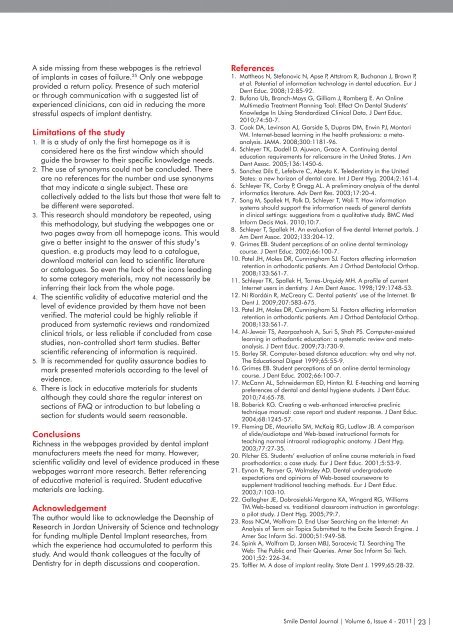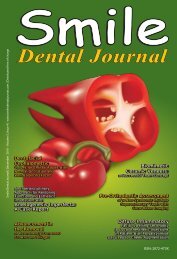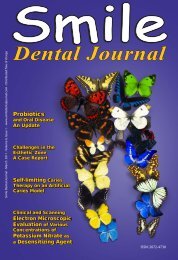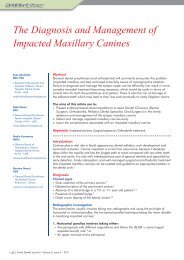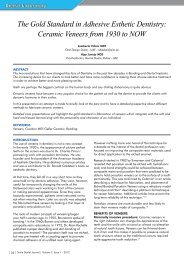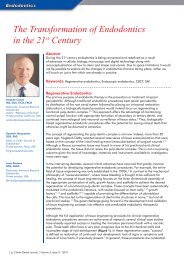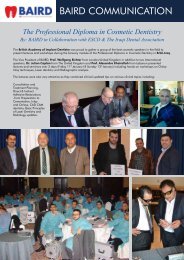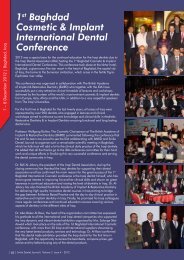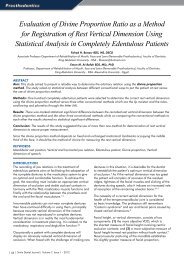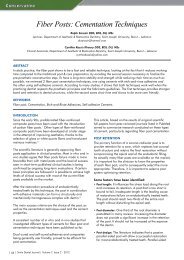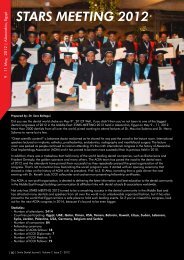Download e-copy - Smile Dental Journal
Download e-copy - Smile Dental Journal
Download e-copy - Smile Dental Journal
You also want an ePaper? Increase the reach of your titles
YUMPU automatically turns print PDFs into web optimized ePapers that Google loves.
(Table 2) Summary of clinical and laboratory stages of NZ<br />
technique<br />
Clinic 1: Upper & lower primary impressions using stock trays<br />
Lab1: Casting primary models and construction of special trays<br />
Clinic 2: Upper & lower secondary impressions<br />
Lab 2: Casting master models and construction of record blocks<br />
Clinic 3: Bite registration<br />
Lab 3: Mounting master casts using CR record on semi-adjustable<br />
or average value articulator. Removal of lower wax rim and fabrication<br />
of baseplate for NZ impression<br />
Clinic 4: NZ impression<br />
Lab 4: NZ impression record mounted on lower master cast, orientation<br />
grooves placed on master cast, putty index adapted around<br />
NZ record and impression material removed and poured in wax<br />
Finally, setting of teeth completed<br />
Clinic 5: Try-in stage. Afterwards, NZ impression refined by tissue<br />
conditioner applied to lower try-in denture<br />
Lab 5: Processing, finishing and polishing<br />
Clinic 6: Insertion of finished dentures<br />
been described after insertion of the denture but using<br />
hard relining material. 27,31<br />
Discussion<br />
Many approaches to set teeth have been advocated and<br />
used in complete denture treatment. 20 However, there<br />
is substantial debate on which of these provide optimal<br />
position in the facio-lingual dimension and guarantee a<br />
favourable outcome in terms of stability, facial support,<br />
chewing efficiency, aesthetics and patient comfort. Some<br />
of these approaches utilized biometric measurements and<br />
location of relatively stable anatomical landmarks to set<br />
teeth; 4 others relied on difference in resorption patterns<br />
to set denture teeth where their natural predecessors<br />
were thought to have been. 34 Some authors adopted a<br />
mechanical concept and advocated setting teeth directly in<br />
the centre of denture support area where the least amount<br />
of leverage is present which in turn enhances the stability<br />
of lower CD. 35 All of these approaches were and are still<br />
being used and each of them proved to have advantages<br />
and disadvantages when compared to others. Furthermore,<br />
these approaches seem to work best when used with<br />
patients who have; their oral and peri-oral musculature<br />
unaltered for any reason, adequate neuromuscular control<br />
and acceptable amount of residual ridge for support.<br />
Unfortunately, the proportion of patients with these features<br />
is dramatically decreasing and so the NZ concept has<br />
become increasingly significant. These observations are<br />
strongly supported by studies investigating the effect of<br />
period of edentulism on position of neutral zone. It has<br />
been found that NZ is closely related to the crest of residual<br />
(Fig. 1) NZ baseplate with<br />
acrylic pillars and wire loop<br />
(Fig. 2) A: NZ impression taken with silicon. B: Putty index<br />
adapted around master cast<br />
ridge in patients who have been edentulous for less than<br />
two years and significantly differs in those who were<br />
edentulous for a period more than that. 16,17<br />
Realizing the importance of the forces generated<br />
by various oral structures on the teeth and polished<br />
surfaces of CDs and their effect on the stability of CD<br />
sheds light on the NZ technique. 1,10 It has been shown<br />
that compromised retention, poor stability, phonetic<br />
problems, inadequate facial support, inefficient<br />
tongue posture/function and increased gagging are<br />
all associated with functionally inappropriate setting of<br />
denture teeth and physiologically inadequate contours<br />
or volume of the denture base. 20<br />
NZ technique has been criticized based on claims that<br />
it is supported by empirical evidence. However, other<br />
authors maintain that this is inaccurate as NZ technique<br />
is based on significant clinical observations on the role<br />
of destabilizing forces the muscles apply to CDs during<br />
functional movements. Furthermore, the large number of<br />
case reports accumulated in a short period of time and<br />
clinical studies conducted by Stromberg & Hickey 36 and<br />
Fahmy & Kharat 37 undermine this criticism and add to<br />
the validity of NZ technique. Stromberg & Hickey 36 found<br />
better patient adaptability to physiologically formed<br />
denture bases when compared to conventional ones.<br />
Fahmy & Kharat 37 found improved comfort and speech<br />
clarity reported by patients upon wearing CD fabricated<br />
using NZ technique when compared to conventional<br />
CD. Moreover, Barrenas and Odman found less post<br />
insertion problems and better patient acceptance in<br />
NZ dentures when compared to conventional ones. 38<br />
(Table 3) Summary of NZ impression clinical technique<br />
Baseplate with acrylic pillars and/or wire loop is fitted in patient’s<br />
mouth and checked for proper extensions and VDO<br />
Baseplate is coated by adhesive and loaded with regular bodied<br />
silicone impression material<br />
While the patient is setting upright and comfortable the baseplate is<br />
inserted in patient’s mouth<br />
Patient is then asked to swallow few time, moisten lips, use tongue to<br />
clear buccal sulci, smile, grin and purse lips<br />
Before final setting of material, patient is asked to read loudly a<br />
vocal passage<br />
Once set, NZ impression removed and inspected for deficiencies<br />
which can be corrected by addition of impression material<br />
Impression disinfected and sent to lab<br />
| 10 | <strong>Smile</strong> <strong>Dental</strong> <strong>Journal</strong> | Volume 6, Issue 4 - 2011


